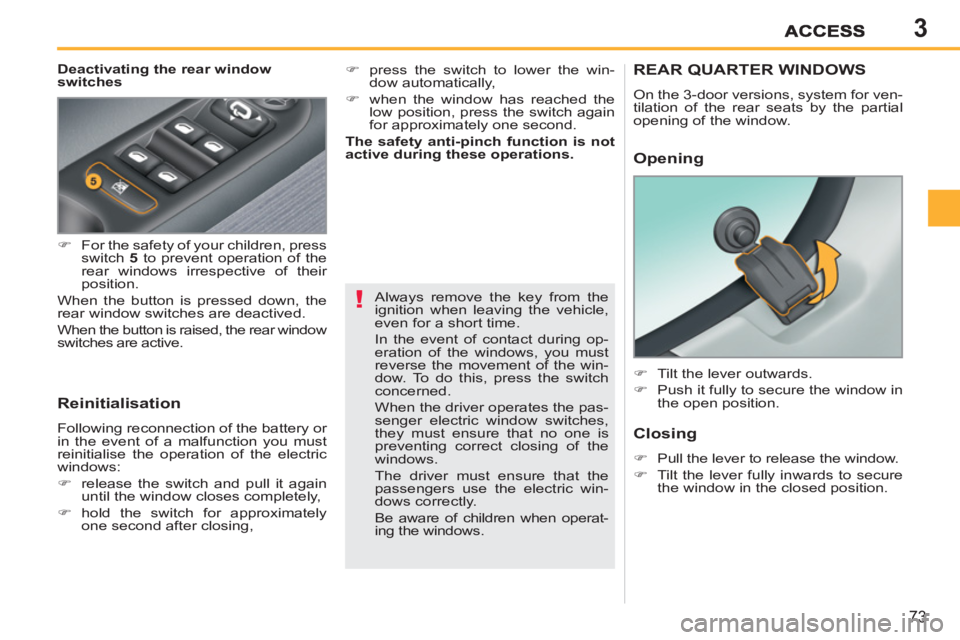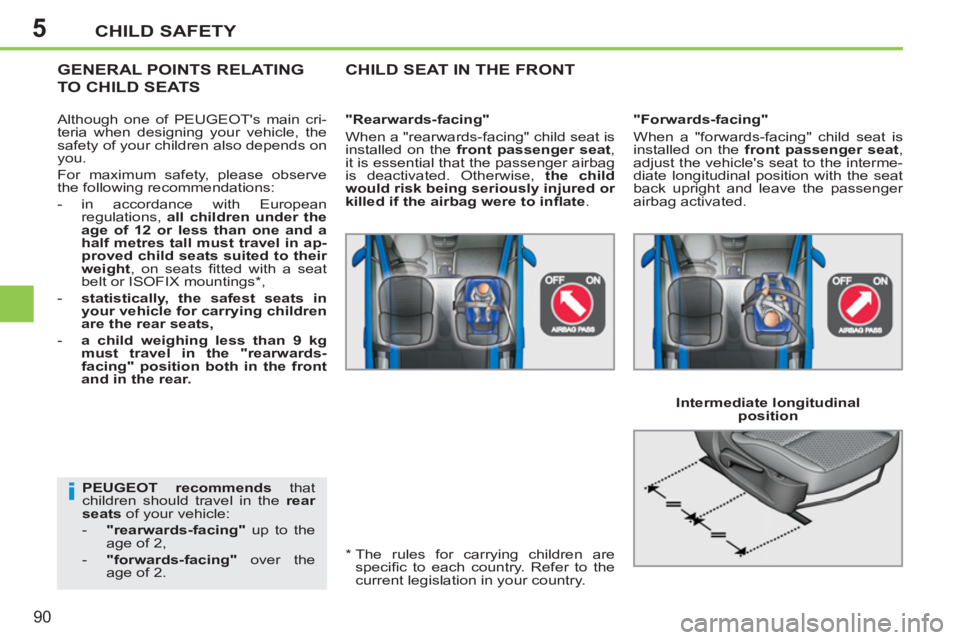Page 4 of 248
2
CONTENTS
Instrument panels 19Indicator and warning lamps 20Indicators 28Adjustment buttons 32Screens without audio system 33Screens with audio system 3516/9 colour screen(Peugeot Connect Navigation) 40Trip computer 42
�„�„�„�„�„�„�„
�„
Ventilation 45Heating 47Manual air conditioning 47Rear screen demist - defrost 49Digital air conditioning 50Front seats 52Rear seats 54Mirrors 57Steering wheel adjustment 59Interior fi ttings 59
�„�„�„�„�„�„�„�„�„�„
COMFORT 45�Î67
Remote control key 68Window controls 72Rear quarter windows 73Doors 74
Boot 76Panoramic sunroof 78Fuel tank 79Misfuel prevention 81
�„�„�„�„�„�„�„�„
ACCESS 68 �Î81
Lighting control stalk 82Headlamp adjustment 85Wiper control stalk 86Courtesy lamps 89
�„�„�„�„
VISIBILITY 82 �Π89
Child seats 90Isofi x child seats 96Child lock 100
�„�„�„
CHILD
SAFETY 90�Π100 FAMILIARISATION 4
�Π16
INSTRUMENTS and
CONTROLS 19 �Î445
4
3
2
1
ECO-DRIVING 17 �Î18
Page 11 of 248
9
FAMILIARISATION
INSTRUMENTS AND CONTROLS
1.
Steering lock and ignition.
2.
Audio equipment steering mounted
controls.
3.
Wiper/wash-wipe/trip computer
control stalk.
4.
Hazard warning lamps switch.
5.
Multifunction screen.
Seat belt fastening status warning
lamps.
6.
Sunshine sensor.
7.
Passenger's airbag.
8.
Glove box/Passenger's airbag
deactivation/Audio/video sockets.
9.
Heated seat control.
10.
Front ashtray.
11 .
12 V accessory socket.
12.
USB port.
13.
Dynamic stability control
(ESP/ASR) button.
Central locking button.
Electric child lock button.
14.
Heating/air conditioning controls.
15.
Storage compartment.
16.
Peugeot Connect Sound or
Peugeot Connect Navigation.
17.
Central adjustable air vents.
Page 17 of 248
!
15
FAMILIARISATION
Front passenger's airbag
START
1.
Open the glove box.
2.
Insert the key.
3.
Select position:
"ON"
(activation), with front passenger
or "forwards facing" child seat,
"OFF"
(deactivation), with "rear facing"
child seat".
4.
Remove the key keeping the switch
in the new position.
��
109
Ignition switch
A.
Front left seat belt not fastened or
unfastened warning lamp on red.
B.
Front right seat belt not fastened or
unfastened warning lamp on red.
C.
Rear left seat belt not fastened or
unfastened warning lamp on red.
D.
Rear centre seat belt not fastened
or unfastened warning lamp on red.
E.
Rear right seat belt not fastened or
unfastened warning lamp lit on red.
��
106
Front and rear seat belts
1.
Stop
position.
2.
Ignition
position.
3.
Starting
position.
��
70
PASSENGER SAFETY
A heavy object (key fob...), attached
to the key and weighing down on
its shaft in the ignition switch, could
cause a malfunction.
Page 24 of 248

1INSTRUMENTS and CONTROLS
22
Deactivation indicator lamps
If one of the following indicator lamps comes on, this confi rms that the corresponding system has been switched off intentionally.
This is may be accompanied by an audible signal and a message on the multifunction screen.
Warning lamp
is on
Cause
Action/Observations
Passenger's
airbag
system
fi xed. The control, located in the
glove box, is set to the OFF
position.
The passenger's front
airbag is deactivated.
In this case you can install
a "rear facing" child seat. Set the control to the ON
position to activate the
passenger's front airbag.
In this case, do not fi t a child seat in the rear-
facing position.
ESP/ASR
fi xed. The button, located
in the centre of
the dashboard,
is pressed. Its
indicator lamp is on.
The ESP/ASR is deactivated.
ESP: electronic stability
programme.
ASR: anti-skid regulation. Press the button again to reactivate the ESP/ASR
manually. Its indicator lamp goes off.
From approximately 30 mph (50 km/h), the
system is reactivated automatically.
The ESP/ASR system is reactivated
automatically when the vehicle is started.
Page 75 of 248

3
!
73
Deactivating the rear window
switches
Reinitialisation
Following reconnection of the battery or
in the event of a malfunction you must
reinitialise the operation of the electric
windows:
�)
release the switch and pull it again
until the window closes completely,
�)
hold the switch for approximately
one second after closing, Always remove the key from the
ignition when leaving the vehicle,
even for a short time.
In the event of contact during op-
eration of the windows, you must
reverse the movement of the win-
dow. To do this, press the switch
concerned.
When the driver operates the pas-
senger electric window switches,
they must ensure that no one is
preventing correct closing of the
windows.
The driver must ensure that the
passengers use the electric win-
dows correctly.
Be aware of children when operat-
ing the windows.
REAR QUARTER WINDOWS
On the 3-door versions, system for ven-
tilation of the rear seats by the partial
opening of the window.
Opening
�)
For the safety of your children, press
switch 5
to prevent operation of the
rear windows irrespective of their
position.
When the button is pressed down, the
rear window switches are deactived.
When the button is raised, the rear window
switches are active.
Closing
�)
Pull the lever to release the window.
�)
Tilt the lever fully inwards to secure
the window in the closed position.
�)
Tilt the lever outwards.
�)
Push it fully to secure the window in
the open position.
�)
press the switch to lower the win-
dow automatically,
�)
when the window has reached the
low position, press the switch again
for approximately one second.
The safety anti-pinch function is not
active during these operations.
Page 92 of 248

5
i
CHILD SAFETY
90
PEUGEOT recommends
that
children should travel in the rear
seats
of your vehicle:
- "rearwards-facing"
up to the
age of 2,
- "forwards-facing"
over the
age of 2.
GENERAL POINTS RELATING
TO CHILD SEATS
CHILD SEAT IN THE FRONT
"Rearwards-facing"
When a "rearwards-facing" child seat is
installed on the front passenger seat
,
it is essential that the passenger airbag
is deactivated. Otherwise, the child
would risk being seriously injured or
killed if the airbag were to infl ate
.
*
The rules for carrying children are
specifi c to each country. Refer to the
current legislation in your country. Although one of PEUGEOT's main cri-
teria when designing your vehicle, the
safety of your children also depends on
you.
For maximum safety, please observe
the following recommendations:
- in accordance with European
regulations, all children under the
age of 12 or less than one and a
half metres tall must travel in ap-
proved child seats suited to their
weight
, on seats fi tted with a seat
belt or ISOFIX mountings * ,
- statistically, the safest seats in
your vehicle for carrying children
are the rear seats,
- a child weighing less than 9 kg
must travel in the "rearwards-
facing" position both in the front
and in the rear.
Intermediate longitudinal
position
"Forwards-facing"
When a "forwards-facing" child seat is
installed on the front passenger seat
,
adjust the vehicle's seat to the interme-
diate longitudinal position with the seat
back upright and leave the passenger
airbag activated.
Page 93 of 248
5
!
CHILD SAFETY
91
Passenger airbag OFF
Refer to the advice given on the label present
on both sides of the sun visor(s):
CAUTION
RISK OF DEATH OR SERIOUS INJURY.
DO NOT install a child seat facing rearwards on the front seat, which is fi tted
with an airbag.
Page 94 of 248
5CHILD SAFETY
92
CHILD SEATS RECOMMENDED BY PEUGEOT
PEUGEOT offers a complete range of recommended child seats which are se-
cured using a three point seat belt
:
Group 0+: from birth to 13 kg
L1
"RÖMER Baby-Safe Plus"
Installed in the rearwards-facing position.
Groups 2 and 3: from 15 to 36 kg
L3
"RECARO Start''
L4
"KLIPPAN Optima"
From the age
of 6 years
(approximately 22 kg),
the booster is used on
its own.
L5
"RÖMER KIDFIX"
Can be fi tted to the vehicle's ISOFIX mountings.
The child is restrained by the seat belt.